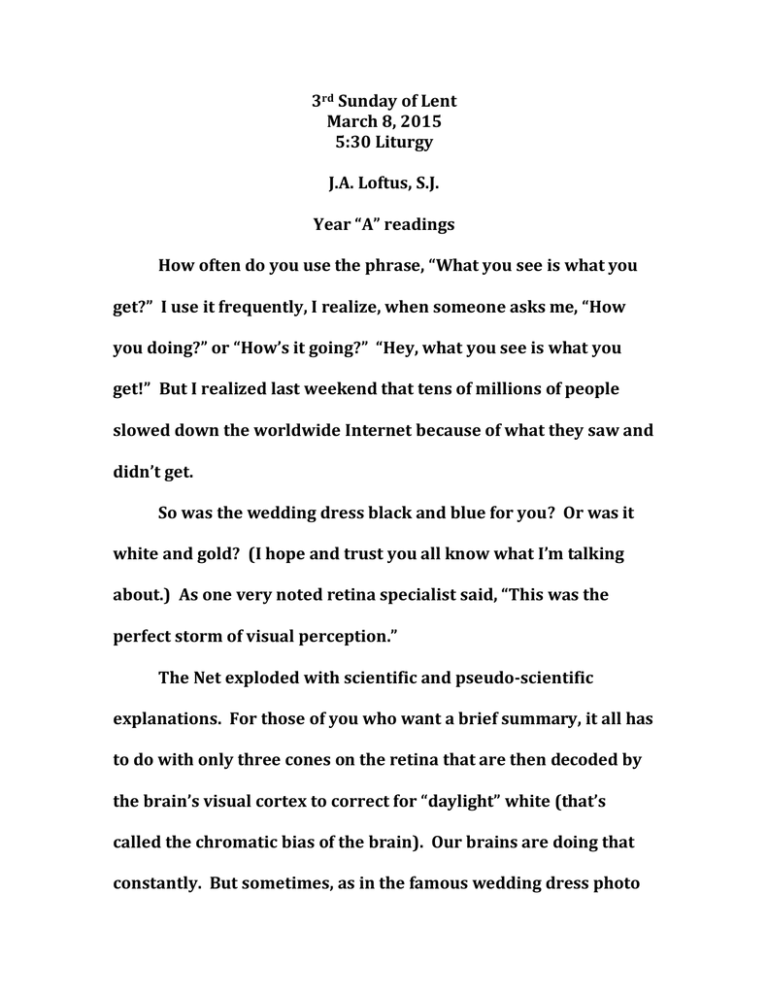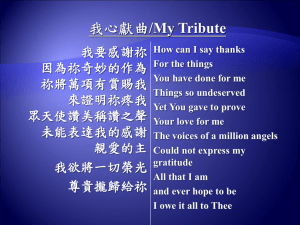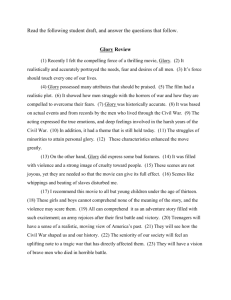3 Sunday of Lent March 8, 2015 5:30 Liturgy
advertisement

3rd Sunday of Lent March 8, 2015 5:30 Liturgy J.A. Loftus, S.J. Year “A” readings How often do you use the phrase, “What you see is what you get?” I use it frequently, I realize, when someone asks me, “How you doing?” or “How’s it going?” “Hey, what you see is what you get!” But I realized last weekend that tens of millions of people slowed down the worldwide Internet because of what they saw and didn’t get. So was the wedding dress black and blue for you? Or was it white and gold? (I hope and trust you all know what I’m talking about.) As one very noted retina specialist said, “This was the perfect storm of visual perception.” The Net exploded with scientific and pseudo-scientific explanations. For those of you who want a brief summary, it all has to do with only three cones on the retina that are then decoded by the brain’s visual cortex to correct for “daylight” white (that’s called the chromatic bias of the brain). Our brains are doing that constantly. But sometimes, as in the famous wedding dress photo that appeared on Twitter, some of our brains just can’t handle it. Hence, the many friendships and even marriages that got strained or broken last weekend! Now I’m sure most of you immediately remembered a series of homilies I offered a few years back about “The Invisible Gorilla.” That was much the same thing. That illustrated how the brain can easily get distracted, so distracted that people literally don’t see a big gorilla prance across a video of folks playing with basketballs. So, conclusion number one: sometimes what you see is not exactly what you get! That’s true of today’s gospel story too. Sometimes words get in the way of even more astounding things that are happening right in front of our noses. St. John’s original listeners or readers would have had a very hard time getting past the first paragraph of today’s gospel. John’s rather lengthy theological discourse, or his portrayal of Jesus as the clever mind reader who details the woman’s love life, would not have interested them so much. They would get stuck at the beginning: He actually sat down at Jacob’s well in Samaria, of all places, and then asked a woman for a drink. Good God, what was Jesus thinking? 2 Samaritans were not just theologically confused or “strange” people; they were “the enemy.” Jews and Samaritans rarely spoke to each other, let alone sit down to have a drink together. They were sworn enemies. The Samaritans were the ultimate “outcasts,” foreigners, undesirables, and “dirty” people to boot. Yes, the Jews considered most Samaritan women ritually impure from birth. (Read Amy-Jill Levine’s commentary on St. Luke’s parable of the socalled “good” Samaritan. Good Samaritans represent the ultimate oxymoron. There is no such thing. In Short Stories by Jesus: The Enigmatic Parables of a Controversial Rabbi.) This story is not about mind reading. It is about inclusion. This gospel is presented in Lent to remind us that the journey is not just about “giving up” something for 40 days; it is much more about just “giving” of yourself, and sometimes giving of yourself to stranger people than Samaritans. Yes, it is about the living waters of baptism and about Eucharist, but because those mysteries belong finally to the new place of worship, which is neither in Jerusalem nor in Samaria. The new place of worship is in the Body of Christ. It is here, and today! 3 You can get the real point of today’s gospel, oddly enough and powerfully, on You Tube. Re-watch the Academy Award performance of the best original song “Glory,” from the film Selma. And listen to the acceptance speeches of John Legend and Common. In the movie they are standing on the Edmund Pettus Bridge in Selma, Alabama. He was the Grand Knight of the Ku Klux Klan. It is the site 50 years ago of Dr. Martin Luther King’s march on Selma and the very spot at which they clashed with police. They recreated that scene dramatically at the award show. Common’s acceptance speech was poetry. He said: “The spirit of this bridge transcends race, gender, religion, sexual orientation, and social status….This bridge was built on hope. Welded with compassion. And elevated by love for all human beings.” St. Paul says today, “we boast in hope of the glory of God.” Sing of that glory on a bridge in Selma, Alabama. Sing of God’s glory near a well named for Jacob. But sing Glory for God’s sake! We are not yet there! But we can sing of God’s Glory that is there. That’s really the point of St. John’s story. And that glory, God’s Glory, seeks to include everybody, even the Samaritans in 4 our midst. We, you and I, can make that more of a reality in this Lenten season. Sometimes what you see can be what you get. But it takes work! Peace! 5








